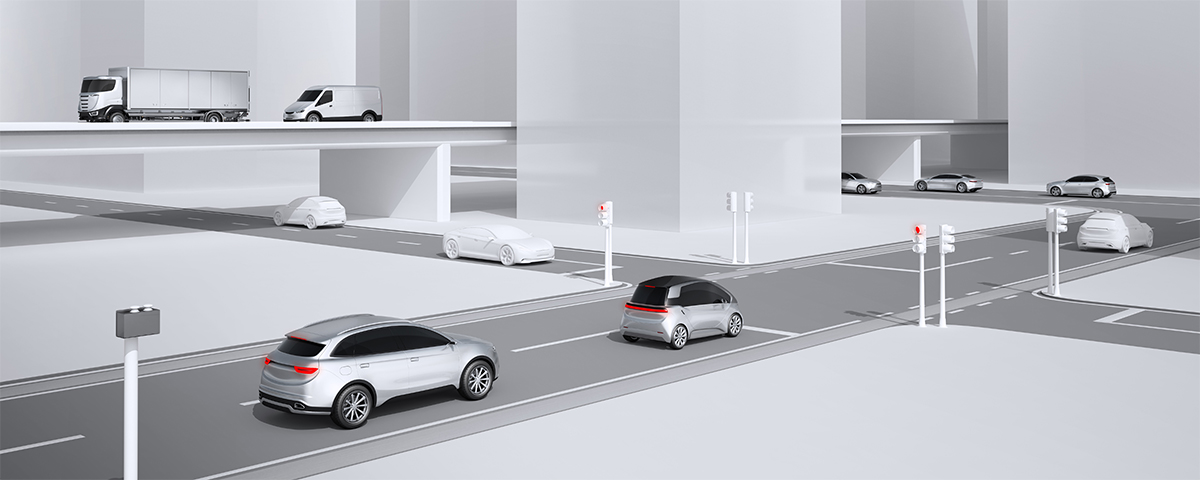Are you interested in our solutions? Then write us a message. Our sales team will be happy to help you.
Fewer emissions for better air quality
with innovative solutions for vehicles and support for cities
with optimized technology for vehicles with combustion engines
with scalable electric powertrain systems for many vehicle segments
by measuring immissions for optimized traffic management

The quality of the air around us depends on many factors and can vary widely from one location to another – sometimes even a few meters can make a difference. Emissions from many different sources (emitters) contribute to a deterioration in air quality. In this regard, nitrogen oxides and particulate matter are currently regarded as the most relevant types of air pollution, particularly in terms of air quality in large cities. However, natural factors such as temperature, wind conditions and solar radiation also have a major impact on air quality.
Road traffic is by no means the only source of emissions. Emissions from other sources are also responsible for increasing air pollution. The primary emitters of particulate matter, for example, are agriculture, industry, power stations, fireplaces and heating in homes, and road traffic. Emissions of particulate matter are produced independently of the type of vehicle powertrain, as a high percentage is caused by road and tire wear particles as well as brake dust.
In order to understand air quality, air pollution and their effects on people and the environment, it is important to distinguish between emissions and immissions. Emissions refer to output at its respective source, e.g. the nitrogen oxide output by a car directly at its exhaust pipe. In other words, what comes out at the back. Immissions, however, denote the volume of these emissions at a certain place with their corresponding impacts.
For example, particulate matter emissions do not have the same effect everywhere; a certain percentage sticks to the ground, is blown away by the wind or washed away by rain. Accordingly, only a small percentage is actually inhaled by people. Stations for measuring air quality do not therefore record all emissions in their entirety, but rather only the percentage which actually reaches them in the form of immissions. As they potentially record percentages of emissions from every conceivable source, they cannot be attributed to individual emitters any longer.
In order to understand air quality, air pollution and their effects on people and the environment, it is important to distinguish between emissions and immissions. Emissions refer to output at its respective source, e.g. the nitrogen oxide output by a car directly at its exhaust pipe. In other words, what comes out at the back. Immissions, however, denote the volume of these emissions at a certain place with their corresponding impacts.
For example, particulate matter emissions do not have the same effect everywhere; a certain percentage sticks to the ground, is blown away by the wind or washed away by rain. Accordingly, only a small percentage is actually inhaled by people. Stations for measuring air quality do not therefore record all emissions in their entirety, but rather only the percentage which actually reaches them in the form of immissions. As they potentially record percentages of emissions from every conceivable source, they cannot be attributed to individual emitters any longer.
Carbon dioxide is a greenhouse gas prevailing in nature which also arises when fossil energy sources are burned. An increased concentration of CO2 in the air contributes to global warming. For this reason, reducing CO2 emissions worldwide is a central goal pursued by climate protection.
Nitrogen oxides are oxygen compounds (oxides) of nitrogen and also a naturally occurring gas. However, the largest shares of NOx are produced during combustion processes. That is why NOx pollution is higher in densely-populated urban centers than in the countryside. It was possible to reduce NOx emissions by road traffic in Germany by almost 70%** between 1990 and 2015. And they can be reduced even further using technology which is already available today.
Particulate matter comprises a complex mixture of solid and liquid particles. A distinction is made between various categories depending on the particle diameter: PM₁₀ with maximum 10 micrometers, PM₂.₅, and ultra-fine particles with a diameter of less than 0.1 micrometers.
*Quelle: EEA, Greenhouse gas data viewer (2018)
**Quelle: EEA, Air pollutant emissions data viewer (2018)
Are you interested in our solutions? Then write us a message. Our sales team will be happy to help you.

